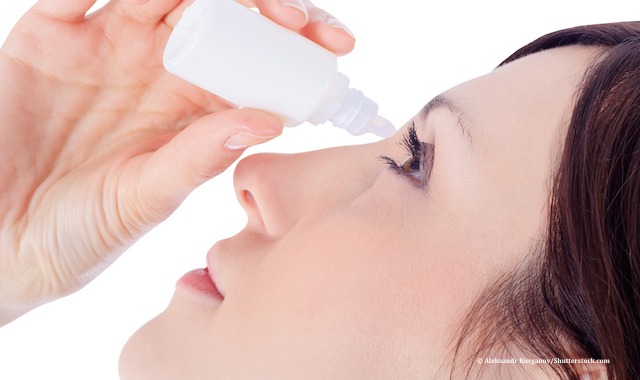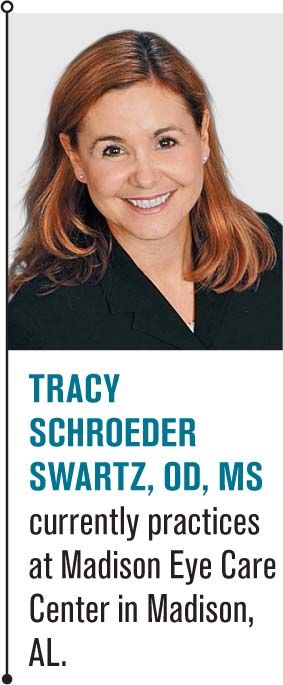Helping patients through the dry eye season
Dr. Tracy Schroeder-Swartz explains the “dry eye season” and how to help patients affected by it.


The views expressed here belong to the author. They do not necessarily represent the views of Optometry Times or UBM Medica.
Winter is here. For many, that means illness, lost work, missed school days, lots of copays to pay, and (my favorite) dry eye season.
I describe the “dry eye season” as ranging from Halloween to Valentine’s Day. I live in Alabama, so yours might be longer. If it is, you should move here. I have a love-hate relationship with winter.
Humidity in the air
Heating of cold air reduces humidity in the air. Humidity is relative because cold winter air contains far less moisture than warmer summer air, even when saturated. Relative humidity is the percent of water saturation of the air, and it is temperature dependent. One cubic foot of air when the temperature is 0° requires only 0.001 ounce of water to saturate it. Some 0.022 ounces of water is required to saturate that one cubic foot of air at 80 degrees.
Previously from Dr. Schroeder-Swartz: Balancing work and home as an OD during the holidays
Hence, the air is drier this time of the year. The drier air desiccates mucous membranes, causing inflammation. This results in dry skin, irritated sinuses, scratchy throats, contact lens problems, and scratchy eyes. A compromised mucous membrane fails to protect the body, increasing risk of colds, flu, and other infections.
Infection
Infectious diseases enjoy increased incidence during the winter months due to children staying inside, more people using mass transit, and parents of sick children taking the germs to work or into public places. Infections that increase during winter months include the common cold, the flu, acute ear infections, bronchiolitis, and norovirus.1
Epidemics of colds and flu impact our families, our offices, and our patients. Our patient schedules may fluctuate dramatically, and our staff tends to call out sick either from personal illness or sick children. In the United States, flu viruses increase during the winter months. Influenza infection often begins to increase in the months of October and November. Typically, flu activity peaks between December and February and may last as late as the month of May.2
Related: The changing dry eye dynamic
There are many different flu viruses, which are constantly changing. The composition of flu vaccines in the United States is reviewed annually and updated yearly in an attempt to match currently circulating flu viruses. Nasal vaccines are not recommended for the 2017-2018 flu season.
Flu vaccines are created to protect against the three or four viruses that research suggests will be most common for the coming season. For the 2017-2018 season, three-component vaccines are recommended to contain:
• An A/Michigan/45/2015 (H1N1)pdm09-like virus (updated)
• An A/Hong Kong/4801/2014 (H3N2)-like virus
• A B/Brisbane/60/2008-like (B/Victoria lineage) virus
Quadrivalent, or four-component, vaccines, protect against a second lineage of B viruses. These are recommended to be produced using the same viruses recommended for the trivalent vaccines listed above as well as a B/Phuket/3073/2013-like (B/Yamagata lineage) virus.3
How to help
In an effort to reduce infection rates, wash everything. Washing hands, surfaces, basically everything, and covering ones month when coughing is highly recommended.
Related: Dry eye checklist may help ODs treat patients more efficiently
It is also beneficial to increase the humidity in the air. The majority of adverse health effects caused by relative humidity would be minimized by maintaining indoor levels between 40 and 60 percent.4 This requires humidification of the air daily using evaporative or steam humidifiers. Cool mist humidifiers should not be used because they can disseminate allergens and aerosol contaminants.
Vaporizers can be used at night, but they must be placed where the steam will not injure anyone by being stepped on in the dark. Placing bowls of water around the home or office space and refilling them as needed is also beneficial and inexpensive. I send my patients to the dollar store for $1 vases and decorative stones or beads, which make great humidifiers when filled with water.
Humidification is important for ocular surface disease treatment as well. Patients may not understand they need to increase tear supplements. Regular usage of tears and medications is critical.
Educating patients
I discuss dry eye season with my patients year round. Be proactive about dry eye treatment during this time period. I educate my patients what to expect during dry eye season all year, and I plan their return to office during this time. I have as many current dry eye patients as possible return to see me in late November and early December. For those who are new to my practice, I may see them several times over this period to ensure they are improving and comfortable.
I also educate patients that controlling dry eye in the winter months may be an uphill battle, and they are more likely to be symptomatic. I tend to be more aggressive with treatments during this time. For example, if I want to initiate treatment of meibomian gland dysfunction in June, I explain that we are going to supplement with omega-3 fatty acids and start regular use of lipid-containing tears. I would consider adding topical azithromycin or oral doxycycline if treatment was initiated in October, given we are moving into the drier season.
If starting treatment in December, I mention that if the patient does worsen over the next few months, that is actually an improvement, not a treatment failure. This is because it is more difficult to control symptoms during this time of year. Education is especially important for those undergoing cataract surgery or refractive surgery because ocular surgery may increase ocular surface disease.
Related: New products, advancements in dry eye
This season can be a problem for contact lens wearers as well if the drier air prevents them from wearing their contact lenses comfortably. Some may discontinue wear completely during this time. For this reason, I mention dry eye season to this patient population as well.
Finally, I try to see as many patients who call with ocular complaints during dry eye season. They stay with you forever if you give them happier eyes for the holidays.
References
1. Galimberti K. 5 Easy-spread illnesses over the winter. AccuWeather. Available at: https://www.accuweather.com/en/weather-news/fall-winter-illnesses-flu-noro/34682492. Accessed 12/18/17.
2. Centers for Disease Control and Prevention. Current & Past Flu Seasons. Available at: https://www.cdc.gov/flu/about/season/index.html. Accessed 12/18/17.
3. Centers for Disease Control and Prevention. Frequently Asked Flu Questions 2017-2018 Influenza Season. Available at: https://www.cdc.gov/flu/about/season/flu-season-2017-2018.htm. Accessed 12/1/2017.
4. Arundel AV, Sterling EM, Biggin JH, Sterling TD. Indirect health effects of relative humidity in indoor environments. Environ Health Perspect. 1986 Mar;65:351-61.
Newsletter
Want more insights like this? Subscribe to Optometry Times and get clinical pearls and practice tips delivered straight to your inbox.




.png&w=3840&q=75)











